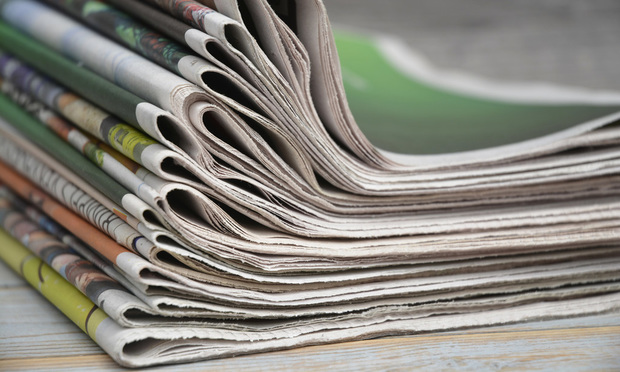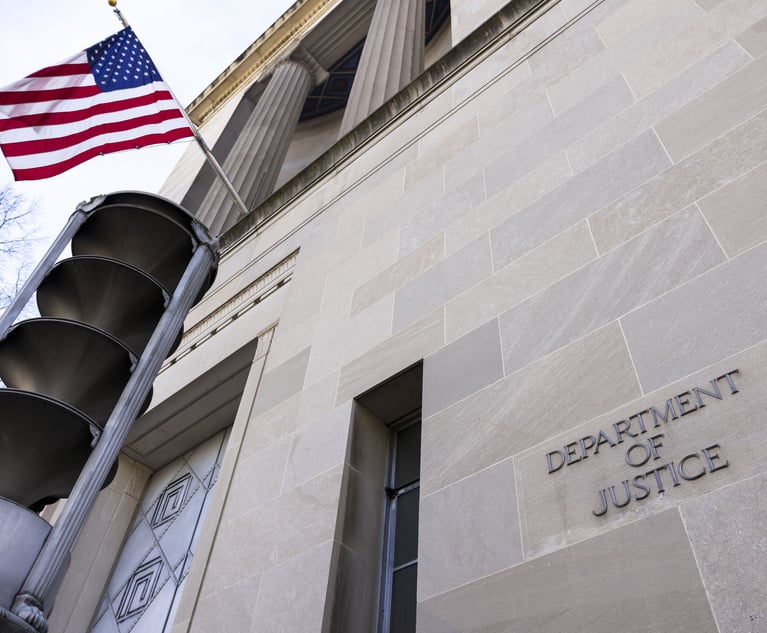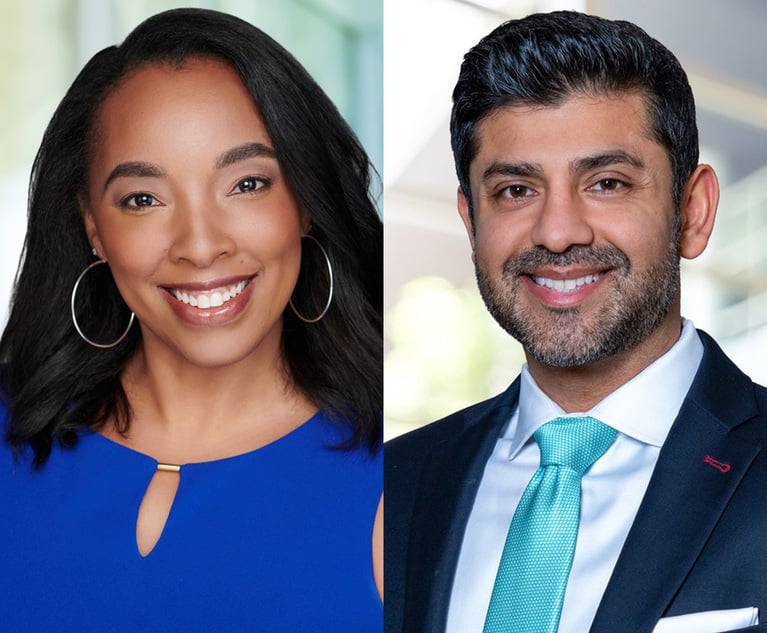The First Amendment Crisis You Probably Haven't Heard About
The decline of proactive litigation by news organizations has had a profound negative effect on the public's access to information.
December 16, 2019 at 06:00 PM
5 minute read

Editor's note: The American Lawyer recently announced the first winners of the Tony Mauro Media Lawyer Award, established to honor attorneys who zealously advocate for freedom of the press.
Anyone who follows the media knows that a seismic shift is underway in the way Americans produce and consume journalism. The financial decline of the legacy media has been exhaustively documented—its causes, effects and larger social import—and the rise of independent, startup and nonprofit media over the same period has been similarly chronicled.
But one aspect of this evolution has gone largely overlooked—one with huge ramifications not just for journalism but for First Amendment freedoms generally: the involvement of lawyers in helping journalists do what they do. That relationship, once robust, has for years been on life support, at least at the local level.
While hard numbers are hard to come by, it's clear from my organization's experience that news organizations are waging far fewer of the legal fights that were once routine — bringing lawsuits under public records laws; going to court to force the disclosure of sealed documents; aggressively defending reporters who are subpoenaed.
Traditionally, even relatively small regional outlets had either staff counsel or an attorney on retainer to help with public records requests and the inevitable recalcitrance from government agencies. They would handle subpoenas and other legal threats, or initiate litigation when necessary. These kinds of lawyers are still practicing, but they see less of this work every year.
The simple reason: money. Newsroom revenues and circulation have been on a well-documented and deep slide for years. And jobs have disappeared: 25% of newsroom positions were cut in the last decade, driven largely by the decline of newspapers. Those who stay in the business but work as freelancers or for small, alternative or nonprofit news organizations often have less access to routine legal support.
And while there are still lawyers specializing in this work and fighting important battles, the decline of proactive litigation by news organizations has had a profound negative effect on the public's access to public records and meetings, and on the ability of journalists to simply do their jobs.
History has shown that when journalists are supported by competent, experienced counsel, First Amendment freedoms thrive. Indeed, it is arguably only through this journalist-lawyer relationship at the local level that the right to free speech, a free press and government transparency can fully flower.
Though guaranteed in the abstract by the First Amendment, these rights are really only put into working effect when cases are brought to court. If cases aren't brought at all, the public's right to see public records, attend public meetings and say what they want wither on the vine.
Who is bringing these cases today? Nonprofit groups like the First Amendment Coalition and Reporters Committee for Freedom of the Press, as well as the largest news organizations, which are the exception proving the rule.
My organization, a small nonprofit in Northern California, regularly sues for access to public records in state and federal court. We also bring actions to enforce California's open-meetings laws, and file motions to unseal court records. Luckily, a number of experienced and dedicated media lawyers at firms both large and small have been willing to do this work pro bono or at deeply discounted rates.
Our caseload has grown of late. But our work is not enough by itself.
At the national level, where publications like the Washington Post and New York Times have seen revenues surge since the 2016 election, the practice of media law is perhaps as robust as ever. But long gone are the days when smaller news organizations like the Riverside Press-Enterprise would fight for public access to court proceedings, and do it all the way to the U.S. Supreme Court—not just once, but twice in two years.
Are the Times and Post's legal resources enough to fill the gap? For national issues, maybe. At the local level? No.
There are some encouraging signs, though, with a recent surge in philanthropic support for First Amendment lawyering. Can this reverse the slide, reviving the crucial lawyer-journalist combination that for decades enforced and expanded First Amendment freedoms? Perhaps. Organizations like the one I lead have seen increased support from donors large and small, and there have been a few very large gifts to organizations fighting for journalists.
But there are troubling indications that as newsrooms stayed away from court in recent decades, government agencies absorbed the dangerous message that nobody is minding the store. And so these government agencies increasingly feel free to obfuscate and obstruct at will.
Take California this year. There was a spate of affronts to press freedoms and government transparency, including an armed raid of a journalist who wouldn't reveal his sources. Governments at the state and local levels betrayed an ignorance of, and disrespect for, First Amendment freedoms that is hard to imagine happening in decades past.
There can be little question that both lawyers and newsrooms would welcome a revival of their long-dormant relationship—and that such a revival would be good for free speech, a free press and government transparency. The question is whether that can happen again in our new media landscape.
David Snyder, a lawyer and former newspaper reporter, is executive director of the First Amendment Coalition.
This content has been archived. It is available through our partners, LexisNexis® and Bloomberg Law.
To view this content, please continue to their sites.
Not a Lexis Subscriber?
Subscribe Now
Not a Bloomberg Law Subscriber?
Subscribe Now
NOT FOR REPRINT
© 2025 ALM Global, LLC, All Rights Reserved. Request academic re-use from www.copyright.com. All other uses, submit a request to [email protected]. For more information visit Asset & Logo Licensing.
You Might Like
View All
Government Attorneys Face Reassignment, Rescinded Job Offers in First Days of Trump Administration
4 minute read


Energy Lawyers Field Client Questions as Trump Issues Executive Orders on Industry Funding, Oversight
6 minute readTrending Stories
- 1We the People?
- 2New York-Based Skadden Team Joins White & Case Group in Mexico City for Citigroup Demerger
- 3No Two Wildfires Alike: Lawyers Take Different Legal Strategies in California
- 4Poop-Themed Dog Toy OK as Parody, but Still Tarnished Jack Daniel’s Brand, Court Says
- 5Meet the New President of NY's Association of Trial Court Jurists
Who Got The Work
J. Brugh Lower of Gibbons has entered an appearance for industrial equipment supplier Devco Corporation in a pending trademark infringement lawsuit. The suit, accusing the defendant of selling knock-off Graco products, was filed Dec. 18 in New Jersey District Court by Rivkin Radler on behalf of Graco Inc. and Graco Minnesota. The case, assigned to U.S. District Judge Zahid N. Quraishi, is 3:24-cv-11294, Graco Inc. et al v. Devco Corporation.
Who Got The Work
Rebecca Maller-Stein and Kent A. Yalowitz of Arnold & Porter Kaye Scholer have entered their appearances for Hanaco Venture Capital and its executives, Lior Prosor and David Frankel, in a pending securities lawsuit. The action, filed on Dec. 24 in New York Southern District Court by Zell, Aron & Co. on behalf of Goldeneye Advisors, accuses the defendants of negligently and fraudulently managing the plaintiff's $1 million investment. The case, assigned to U.S. District Judge Vernon S. Broderick, is 1:24-cv-09918, Goldeneye Advisors, LLC v. Hanaco Venture Capital, Ltd. et al.
Who Got The Work
Attorneys from A&O Shearman has stepped in as defense counsel for Toronto-Dominion Bank and other defendants in a pending securities class action. The suit, filed Dec. 11 in New York Southern District Court by Bleichmar Fonti & Auld, accuses the defendants of concealing the bank's 'pervasive' deficiencies in regards to its compliance with the Bank Secrecy Act and the quality of its anti-money laundering controls. The case, assigned to U.S. District Judge Arun Subramanian, is 1:24-cv-09445, Gonzalez v. The Toronto-Dominion Bank et al.
Who Got The Work
Crown Castle International, a Pennsylvania company providing shared communications infrastructure, has turned to Luke D. Wolf of Gordon Rees Scully Mansukhani to fend off a pending breach-of-contract lawsuit. The court action, filed Nov. 25 in Michigan Eastern District Court by Hooper Hathaway PC on behalf of The Town Residences LLC, accuses Crown Castle of failing to transfer approximately $30,000 in utility payments from T-Mobile in breach of a roof-top lease and assignment agreement. The case, assigned to U.S. District Judge Susan K. Declercq, is 2:24-cv-13131, The Town Residences LLC v. T-Mobile US, Inc. et al.
Who Got The Work
Wilfred P. Coronato and Daniel M. Schwartz of McCarter & English have stepped in as defense counsel to Electrolux Home Products Inc. in a pending product liability lawsuit. The court action, filed Nov. 26 in New York Eastern District Court by Poulos Lopiccolo PC and Nagel Rice LLP on behalf of David Stern, alleges that the defendant's refrigerators’ drawers and shelving repeatedly break and fall apart within months after purchase. The case, assigned to U.S. District Judge Joan M. Azrack, is 2:24-cv-08204, Stern v. Electrolux Home Products, Inc.
Featured Firms
Law Offices of Gary Martin Hays & Associates, P.C.
(470) 294-1674
Law Offices of Mark E. Salomone
(857) 444-6468
Smith & Hassler
(713) 739-1250










